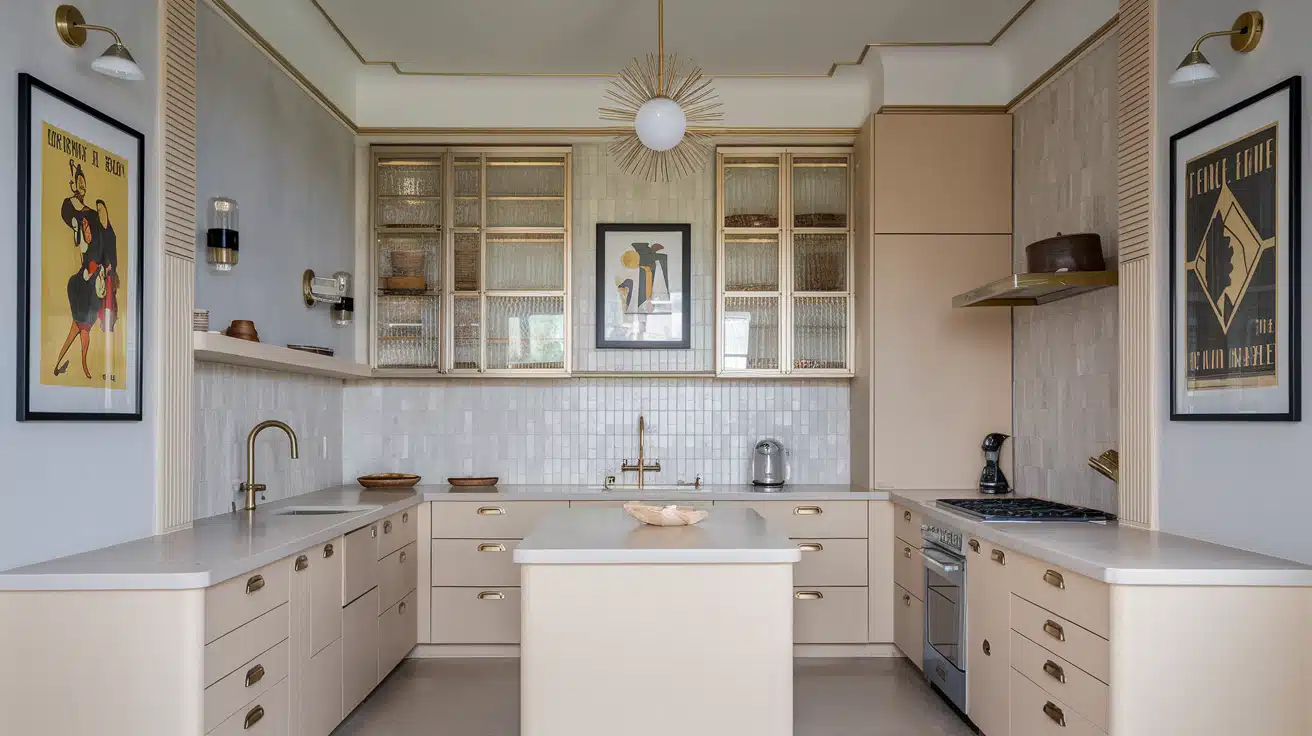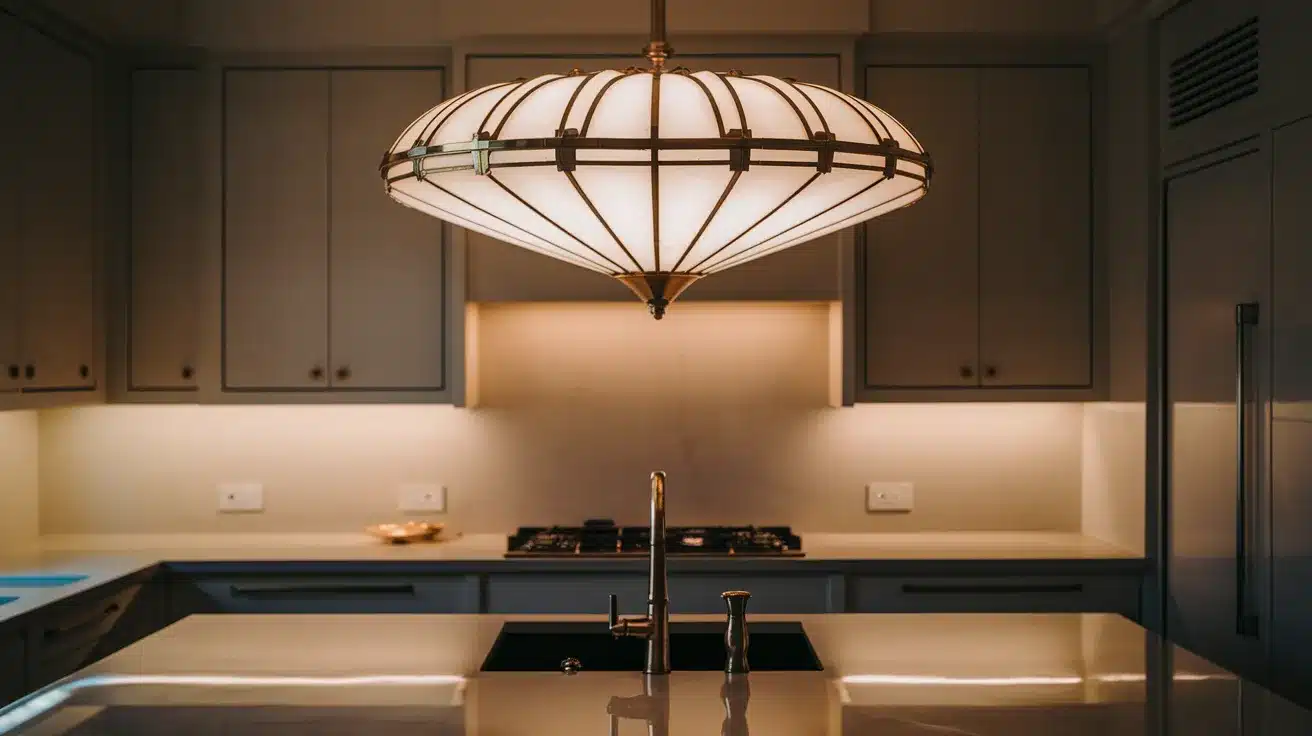Step into the glamorous world of Art Deco kitchens, where bold geometric patterns meet luxurious finishes and vintage sophistication.
This distinctive design movement, which flourished in the 1920s and 1930s, continues to captivate with its perfect balance of ornate details and clean, symmetrical lines.
An Art Deco kitchen transforms an ordinary cooking space into a statement of elegance and character. The combination of rich materials, dramatic contrasts, and architectural precision creates rooms that feel both nostalgic and surprisingly modern.
This guide shows how to add Art Deco charm to your kitchen with design elements like statement lighting, geometric backsplashes, glamorous hardware, and bold colors. Let’s jump in.
What Is an Art Deco Kitchen?
Art Deco, which originated in the 1920s, celebrated luxury and modern life. A kitchen in this style blends beauty with function through clean lines and rich details.
These kitchens stand out for their perfect balance, using shapes like zigzags and sunbursts alongside shiny materials. They mix glamour with practicality, using bold colors against neutral backdrops.
Art Deco works well in kitchens because it makes everyday spaces feel special while still being functional for cooking and gathering.
Must-Have Elements of Art Deco Design
- Strong geometric patterns in flooring or backsplashes
- Metallic accents (chrome, brass, or gold)
- Bold color combinations (black/white, emerald/gold)
- Symmetrical layouts and balanced design
- Statement lighting fixtures
- Luxurious materials (marble, glass, mirrors)
- Clean lines with decorative details
11 Ideas for An Art Deco Kitchen
Redesign your kitchen into a gorgeous Art Deco showcase with these design elements that capture the essence of this timeless style. Each feature can stand alone as a statement piece or be combined for a full Art Deco experience.
1. Use Black and Gold for Instant Glam
The combination of black and gold creates immediate visual impact and luxury appeal. This classic Art Deco pairing elevates any kitchen from ordinary to extraordinary, adding refinement through contrast and shine.
Why it works: This iconic color combination creates immediate drama and luxury, instantly signaling Art Deco style.
How to implement: Consider gold-toned hardware against black cabinets, or black countertops with gold fixtures.
Design tip: Balance these bold colors with neutral tones to prevent overwhelming the space.
2. Add a Geometric Tile Backsplash
Geometric patterns form the foundation of Art Deco design. A patterned backsplash serves as functional art, protecting your walls while creating a sensational focal point that draws the eye and defines the space.
Why it works: Geometric patterns are the backbone of Art Deco design, adding visual interest and period authenticity.
How to implement: Choose tiles with zigzag, chevron, or starburst patterns in contrasting colors.
Design tip: Keep surrounding elements simple to let your statement backsplash shine.
3. Choose Cabinets with Chrome or Brass Handles
Hardware transforms ordinary cabinetry into Art Deco masterpieces. The right handles or knobs add sparkle and dimension to your kitchen, creating points of interest that catch light and attract attention.
Why it works: Metallic hardware adds the perfect touch of glamour and reflects light beautifully in the kitchen.
How to implement: Replace existing pulls with elongated brass handles or stepped chrome knobs.
Design tip: Match your hardware finish to your faucet and light fixtures for cohesion.
4. Install Statement Lighting
Lighting in Art Deco design serves double duty as both illumination and art. The right fixtures become conversation pieces that define your space’s personality while providing necessary task lighting for cooking and entertaining.
Why it works: Dramatic lighting fixtures serve as functional art, creating focal points that define the style.
How to implement: Look for globe pendants, sunburst chandeliers, or geometric sconces with metallic finishes.
Design tip: Hang pendants at different heights for added visual interest and improved task lighting.
5. Use High-Gloss Countertops or Lacquered Finishes
Reflective surfaces capture and amplify light, making kitchens feel larger and more luxurious. These glossy elements embody Art Deco’s emphasis on glamour and modernity, creating a sleek, polished appearance.
Why it works: Shiny surfaces capture the luxurious essence of Art Deco while bouncing light throughout the space.
How to implement: Choose polished stone countertops or add lacquered cabinet fronts in deep colors.
Design tip: Balance high-gloss elements with matte finishes to prevent glare and fingerprint visibility.
6. Try Bold Flooring
Art Deco flooring grounds your design with pattern and personality. Whether subtle or statement-making, the right floor creates a foundation that supports other decorative elements while adding visual interest from the ground up.
Why it works: Bold floors create a strong foundation for your design and establish pattern without cluttering wall space.
How to implement: Install chevron, herringbone, or checkered patterns using tile or hardwood.
Design tip: For busy patterns, keep wall treatments and cabinetry more subdued to prevent visual competition.
7. Add Glass or Mirrored Panels
Reflective elements multiply light and create a sense of expanded space. Glass and mirrors were signature materials in original Art Deco designs, adding sparkle and sophistication to what would otherwise be ordinary surfaces.
Why it works: Reflective materials enhance brightness while adding glamour that’s quintessentially Art Deco.
How to implement: Include mirrored backsplashes, glass-front cabinet doors, or decorative mirror panels.
Design tip: Position mirrors strategically to reflect windows or statement lighting fixtures.
8. Include Rich Colors
Jewel tones add depth and character to Art Deco kitchens. These saturated colors create drama and warmth, transforming neutral spaces into vibrant environments that exude personality and period authenticity.
Why it works: Bold colors like emerald, navy, and burgundy create emotional impact and historical accuracy.
How to implement: Paint an accent wall, choose colored appliances, or incorporate richly colored tiles.
Design tip: Limit your palette to 2-3 strong colors plus neutrals to maintain sophisticatio
9. Style with Vintage-Inspired Bar Stools
Seating elevates function with form in Art Deco kitchens. The right bar stools invite lingering conversations while reinforcing your design theme through distinctive silhouettes and luxurious materials.
Why it works: Period-appropriate seating adds functional sculptural elements to your kitchen landscape.
How to implement: Look for curved backs, channel tufting, velvet upholstery, or brass legs.
Design tip: Choose comfortable seating with proper height for your counter to ensure functionality matches style.
10. Display Art Deco Wall Art or Clocks
Decorative accessories complete your Art Deco kitchen with personality and polish. Wall art and clocks from or inspired by the era add authentic character while filling empty wall space with purposeful design elements.
Why it works: Decorative pieces reinforce your theme and personalize the space without permanent commitment.
How to implement: Hang vintage posters, sunburst clocks, or geometric metal wall sculptures.
Design tip: Frame vintage advertisements or fashion illustrations from the 1920s-30s for authentic character.
11. Mix Modern Appliances with Retro Shapes
Blending contemporary function with vintage enviorment creates kitchens that work as beautifully as they look. This approach honors Art Deco’s forward-thinking spirit while providing the modern conveniences today’s cooks demand.
Why it works: Retro-inspired modern appliances offer the best of both worlds—current technology with period charm.
How to implement: Choose refrigerators with curved corners, range hoods with geometric details, or retro-style small appliances.
Design tip: Look for appliances in unexpected finishes like brass, copper, or matte black rather than standard stainless steel.
How to Get the Kitchen Art Deco Look Without Overdoing It?
Art Deco makes a statement, but balance is key to prevent visual overwhelm. Here are three simple approaches to incorporating this glamorous style tastefully:
Start with One Focal Point: Choose a single standout feature as your design anchor—perhaps a geometric backsplash, statement light fixture, or distinctive hardware set. Let this element be your showpiece while keeping other elements more subdued to complement rather than compete.
Pair Bold Elements with Neutral Surroundings: Frame dramatic Art Deco features with calming neutral backgrounds. White walls, cream cabinetry, or natural wood tones create breathing room that allows bold patterns and rich colors to shine without overwhelming the space.
Avoid Clutter to Keep the Space Sleek: Maintain clean lines and open surfaces to honor Art Deco’s sophisticated essence. Store small appliances behind cabinet doors, select a few meaningful decorative pieces, and prioritize form as well as function in everything visible.
Final Thoughts
An Art Deco kitchen marries the past with the present, offering a unique blend of boldness and refinement that transcends fleeting trends.
The beauty of Art Deco lies in its adaptability. Whether you embrace a single statement piece or commit to a complete transformation, these design principles create kitchens that celebrate both function and style. Start small with metallic hardware or a geometric backsplash, then expand your vision as your comfort grows.
Your kitchen serves as both workshop and gathering space—why not make it extraordinary?
By thoughtfully incorporating Art Deco elements, you’ll create a cooking environment that nourishes both body and spirit while making a confident design statement that’s uniquely yours.



















